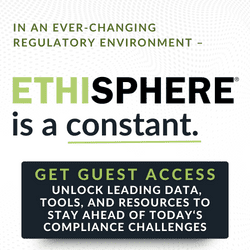How can companies and EHS professionals avoid the many risks of non-compliance? This article discusses five vital measures companies should implement in their EHS operations when approaching environmental compliance reporting. With digitization, visibility, collaboration, productivity and sustainability, companies can drive proactive environmental compliance and more effectively prepare for Tier II reporting.
There are two truths of environmental compliance. First, non-compliance is not an option. Failing to properly comply with environmental regulations can mean financial penalties, reputational damage or even operational stoppage, which are all detrimental for any company. And second, preparing for compliance reporting should be a year-round activity, not just something your environmental, health and safety (EHS) team starts in January to submit Tier II reports by their March 1 due date.
To mitigate the risks of non-compliance, being proactive is not just a concept — it is a mindset businesses must adopt to manage environmental compliance and reporting activities more effectively than they have in the past. Prioritizing proactivity, therefore, is key.
Managing Data Is the Most Significant Hurdle
Historically, enterprises and their EHS operations have used siloed data systems and spreadsheets to collect and organize compliance information. This practice is by far the greatest reason for proactive environmental compliance, which centers largely on transitioning away from disjointed data sources. Leading EHS teams instead rely on a “single source of truth,” or one centralized system to keep track of compliance data. Uppermost on the data front are inventories and quantities of all hazardous substances businesses store or use in their facilities. Chemicals listed in the EPA Consolidated List of Lists must be reported annually to avoid non-compliance, and the completeness and accuracy of such data is critical.
Just as critical is having visibility and complete control over compliance data, which allows EHS and compliance teams to identify when facility-level chemical inventories have exceeded reporting thresholds. Data visibility further enables EHS teams to monitor chemical statuses in distributed facilities, such as chemical types and volumes at each site, track all associated data, and keep a comprehensive, auditable record of reporting for every location..
With digitization, visibility, collaboration, productivity and sustainability as cornerstones, EHS operations can become inherently proactive just by implementing these five aspects of compliance management and reporting. Working in unison, these measures help mitigate the many risks of non-compliance by standardizing data management and streamlining the compliance reporting process.
It is important to keep in mind, however, that different organizations are naturally at different points in their environmental compliance journey. Some companies might well be a few steps ahead in their proactive environmental compliance mission. But focusing on even one new insight and applying it to the compliance reporting process can help companies get closer to the end objective: to never let non-compliance set foot in their business.
1: Digitize Records to Increase Access to Institutional Knowledge
A main reason businesses risk non-compliance is because their reporting processes still rely on paper trails and manual processes to manage information. Many EHS teams are stuck on traditional, outdated means of operating, such as using unvalidated spreadsheets, storing important documents in binders, and communicating back and forth through email to get the reporting data they need. It’s time for businesses to digitally transform their compliance reporting processes, starting with the digitization of records.
Digitization streamlines the Tier II reporting process by converting paper records into a computer-readable format. When data is digitized it is much easier to locate, access and share across equally digitized workflows. Digital data enables EHS teams to then support proactive environmental compliance functions with access to information from a single source of truth, which is vital for making informed decisions quickly.
As reporting data becomes more readily available for EHS teams to share, organizations are also able to conduct thorough quality control/quality assurance (QC/QA) processes to validate data accuracy, minimize errors and maintain a central place to access institutional knowledge year-round.
Teams should also automate reporting processes where possible and extend these processes across corporate and regional and touch points, such as distributed facilities, to standardize reporting functions. A reporting process that is standardized overall stays consistent and repeatable, eliminating the need to start from scratch each reporting cycle. This saves companies and their EHS teams significant time and resources for reporting, and lets them spend more time on compliance efforts such as ESG and sustainability.
2: Increase Data and Process Visibility Between Facilities and Corporate
When data is visible, or transparent, organizations can pinpoint where potential risks lie before they become threatening. EHS teams must be able to analyze and comprehend information accurately, especially for tasks like tracking chemical inventories and discerning reporting thresholds. When information lacks transparency and EHS teams can’t grasp it, they risk submitting reports inaccurately — a main cause of non-compliance violations.
Generally, compliance reporting happens at the facility level, although it is often common for consultants or personnel who work outside of the EHS team to collect data. When data is decentralized and lacks context about who’s reporting it, it can be hard to ensure good data quality.
To ensure misalignment doesn’t occur, organizations should centralize data and create a single source of truth accessible to all persons involved in data collection and reporting activities. Doing so increases data as well as process visibility among facilities and corporate, enabling them to streamline task management, validate data at each step of collection and reporting preparation, and minimize non-compliance risks throughout the entirety of the reporting process.
3: Collaborate Across the Enterprise
To increase compliance confidence, businesses should also prioritize enterprise-wide collaboration. Communicating between people and working together to solve a problem is the core aspect of collaboration, and businesses and their EHS teams can proactively collaborate by creating cohesive workflows for reporting and sharing institutional knowledge. By continually working in unison, teams make timely, more informed decisions and feel comfortable in making them.
EHS operations must look closely at their collaboration practices (or lack thereof), because proactive environmental compliance is nearly impossible without the resulting teamwork. 75% of employers say effective teamwork is critical to the success of their business. Collaboration is central to a successful company culture, in that it creates clear delegation of duties, a faster way to work across departments and geographic locations, better tracking and reporting, and better organization of workplace documents — all things necessary for proactive environmental compliance.
4: Improve Workforce Productivity and Knowledge Sharing
Depending on the number of facilities and hazardous substances stored in them, collecting and assessing data for Tier II reporting can be labor intensive. So is keeping track of new and updated regulatory guidelines every reporting year, which is an overwhelming task for many EHS teams. Teams can additionally be slowed down by having to confirm state regulations, determine if chemicals are characterized as hazardous and verify regulatory applicability for each facility in that specific state. Naturally, then, if a business maintains regulated facilities in multiple states, the demands on an EHS team’s productivity multiply accordingly.
It therefore is critical that team members are highly productive and efficient, to minimize the time-consuming aspects of compliance reporting that can hinder their progress. Businesses can ensure that productivity among team members stays consistent by assigning tasks across various teams, monitoring progress in real-time and constantly coordinating with facility managers to keep work moving quickly.
Another common issue in EHS operations is institutional knowledge of regulatory requirements and the reporting process itself. In many cases, it is not unusual for reporting to fall under the responsibility of a single person — who has likely assumed the role for the past 10-20 years. This person knows every regulatory requirement, can maneuver through every state’s reporting portal for submissions, and has built relationships with key stakeholders in operations for years. This person functions as the single authority and subject matter expert of environmental compliance reporting for the entire organization.
You can imagine the problems this creates when this team member decides to leave or retire from the company, making the knowledge transfer process a critical one. Failing to fully transfer reporting knowledge increases the risks of missed reporting or accidental omissions.
5: Optimize Sustainability Efforts
One last key to proactive environmental compliance is aligning reporting efforts with corporate goals of sustainability. By using digital efficiencies to optimize sustainability, companies can manage compliance both proactively and systematically. This alignment begins by pinpointing issues corporate leaders care most about and how EHS operations affect them.
Common sustainability goals can range from decreasing energy and water consumption to greenhouse gas emissions. However, in an EHS operation, the goals are measured mainly by efficiency. Proactive environmental compliance helps companies maximize sustainability efforts through the digital transformation of compliance management practices.
When companies have a digital foundation for compliance management, corporate leaders and their EHS teams can benefit from vital sustainability-based outcomes. Digitized records, increased data visibility, enterprise-wide collaboration and improved EHS workforce productivity are the outcomes resulting from optimizing sustainability efforts through digital efficiencies. A digital foundation also provides adaptability and scalability for change, company growth and mergers or acquisitions.
Make Environmental Compliance Consistently Successful
Digitization, visibility, collaboration, productivity and sustainability can help substantially promote proactivity in environmental compliance. Again, being proactive must be a mindset — a commitment to do everything possible to mitigate the potential risks of non-compliance. Today’s EHS professionals can adopt technology solutions that allow them to work from a single source of truth, validate compliance data, get a 360-degree view of reporting activities, and transform operational functions via digital transformation — all things that can help corporate leaders and EHS teams alike make proactive environmental compliance their mindset going forward.



 Luke Jacobs is
Luke Jacobs is 








